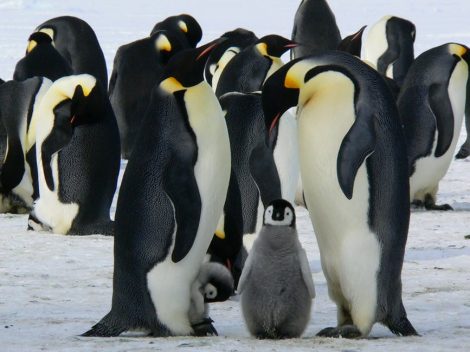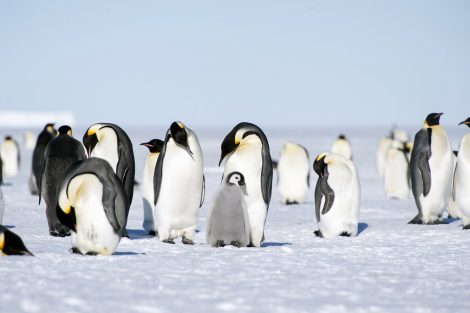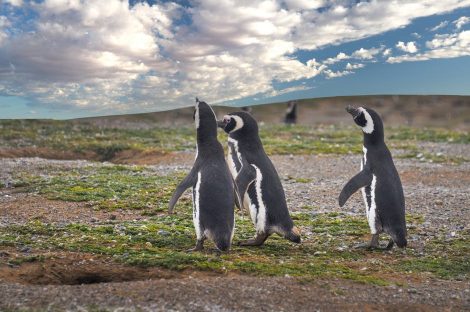When we look at penguins, there will be many questions in mind on the trot. One of the questions amongst the children and many of us are, are penguins cold-blooded or warm-blooded? The answer is warm-blooded.
Before going into the detailed explanation about the answer, let us know, what do cold-blooded and warm-blooded refers to.
Cold-Blooded:
Whichever animal’s body temperature changes according to the external temperature, then those animals are termed as cold-blooded.
For example, insects, amphibians, reptiles, and fishes.
Warm-Blooded:
Whichever animal’s body temperature is high irrespective of the external temperature, then those animals are said to be warm-blooded.
For example, birds and mammals.
Emperor penguins huddling together
Why Are Penguins Warm-Blooded?
Penguins have the fat coat underneath their skin called blubber which plays an important role in keeping the penguins warm. Penguins are very good at maintaining and changing their temperature according to the climate and place. They handle the temperature change seamlessly when they are in the water as well as when they are on the icy land.
Naturally, the animals and birds which are in the extreme cold weathers, are bulky with the fat layer below their skin.
The penguins in Antarctica retain the outer surface of their plumage (feathers) below the temperature of that atmosphere to reduce the heat loss. Added to the fat cover in their body, the outer layer of their skin has layers of tiny feathers which act as a seal during winter. Also, these feathers get a kind of oil over them from the body to serve as water and windproof.
Apart from staying on the icy surface, they also breed on land and also ice, so, the penguins have to acquire the mechanism which helps them and their eggs survive. More than the plumage of the penguin’s body, the fat coating prevails as great insulation during winter when they are in the cold. In the total weight of the penguin, around 30% can be the blubber’s contribution.
What if the Feet and the Flippers of the Penguins Get Cold Severely?
The doubt might be, how the penguins will function if their feet and flippers get extremely cold?
Even though, when the penguin’s feet and flipper get cold, they can function.
Because the feet and the flippers are not managed locally. Instead, the internal sections of the penguin’s body are responsible. So, there will be no disturbance to function if it gets cold. Since there are no muscles in the feet and flippers, it is not responsible for the whole body movement. Thus, the functioning of other parts of the penguins does not get affected by the cold feet and the flippers.
Moreover, the feet of the penguins consists of thick skin, bone, and tendons rather than muscles.
On, more process that is helpful to maintain the temperature is the heat exchange blood flow.
Heat-exchange blood-flow is a phenomenal blood flowing method in the penguin’s body. The warm blood flows to the feet and carries the cold blood up. Some amount of heat from the arteries are again transferred to the veins, and the cold blood is flowing towards the heart is warmed. Thus, it results in maintaining the entire body’s temperature and the warm blood moving to the feet is cooled, and it will be more than the freezing temperature.
The same method of blood flow to the feet is similar to that of the flippers. With this counter-flow blood accomplishment, the penguin’s body parts are managed from getting frozen.
Few emperor penguins tucking their bill under the flipper
The Mechanism to Stay Warm:
The above-explained mechanism is quite similar to the thermal insulation. Penguins are endotherms which generate heat internally. They produce heat and maintain the body temperature irrespective of the external temperature.
When the heat loss is more than the heat generation, the digestion makes up the loss. When the heat generation is greater than the rate of loss then, the evaporation occurs to raise the heat loss. In both the cases, the heat is balanced.
There are also few behavioral changes which the penguins follow to adjust to the severe cold weather.
1) Not Contacting the Icy Surface Directly:
The penguins do not lie on the icy surface because they want to avoid the direct hit of the cold temperature.
They follow the behavior of standing on the heel by lifting up the tip of the toes. The whole body weight is exerted on the heel, and the body balances for a very long time because of their mass.
2) The Hidden Bill Under the Flipper:
You might have noticed certain emperor penguins tucking their bill (beak) under the flipper. To reduce the cold reaching directly to the nasal passages, they want their beak hidden from the direct cold air.
3) Huddle Up:
The penguins which are in the icy atmosphere will huddle up with the other penguins to get warmer and reduce the sole effort.
This behavior also helps in saving the body fat. The cold surface will be occupied by the group and thus reduce the severe cold entering the penguin’s body. They huddle up in thousands to be safer and warmer.
When the penguin is single rather than in being the group, it can burn up to 200g fat. Whereas, the penguins in the huddle burn only to 100g fat, which is almost half the rate from the one which is lone.
The Penguins also tremble to produce supplementary heat.
4) Helpful Heat Exchange:
Penguins bring back 80% of heat evading through their breath. The heat exchange process also contributes to maintaining the temperature when they are in the colder regions.
5) Resting
Penguins are in the hibernated state for long hours to preserve their energy to survive in the coldest weather. Their fat layer may not be sufficient, and the food intake may not be appreciable to hold them, in this case, they sleep for quite a good time.
6) Preening
Preening is nothing but the process of rearranging the feathers. Almost all the bird species does this to get saved from the cold climatic conditions. They rearrange their feathers to support the temperature imbalance. Penguins overlap their feathers to avoid the wind or moisture entering the skin. By the way, they can stay in a cold place. Along with other behaviors this one also aids in the adverse conditions.
Fairy Penguins with less body mass and height
7) Penguins when Overheated:
When they are in the land overheating may be a problem where the penguins go under a shaded area as other creatures.
Also when they have heated temperature, then they spread their flippers wide from their body to release the heat to the air. Species like African penguins do not have tiny feathers over their feet as Antarctic penguins.
When the body temperature is more, the warm-blooded animals will show the changes like widening the skin when the body gets the heat to the surface.
Conclusion:
Penguins in the colder regions have long feathers and more fat under their skin when compared to the ones in the warmer place. The warm-blooded animals’ body temperature is the same for any climate, no matter is sunshiny or frosty. Cold-blooded animals change hotter and colder according to hot and winter climate. Thus, from the above information, we can conclude that the penguins are 100 percent warm-blooded.
References:
http://coolcosmos.ipac.caltech.edu/image_galleries/ir_zoo/coldwarm.html
https://www.livescience.com/32495-why-dont-penguin-feet-freeze-on-ice.html
Penguin Adaptations for Survival in Antarctic Climates
http://www.antarctica.gov.au/about-antarctica/wildlife/animals/adapting-to-the-cold
Image source:


